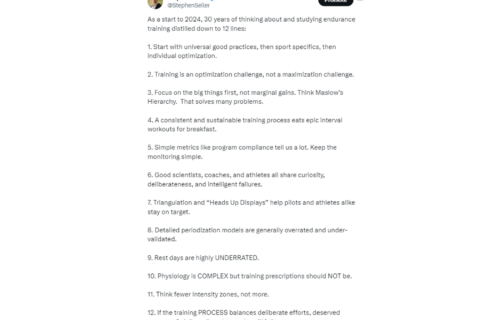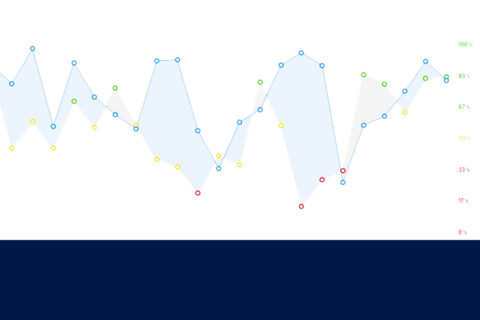Coach Trevor Connor and Coach Ryan Kohler walk through their process for interpreting 5×5-minute interval workout sessions in TrainingPeaks.
Video Transcript
Trevor Connor 00:05
Welcome everybody to the first of what we hope is a long running series, I’m here with our head coach, Ryan Kohler. Hey, Ryan.
Ryan Kohler 00:14
Hey, Trevor.
Trevor Connor 00:15
So Ryan and I have both been coaching for far longer than we would like to admit to, so over the years, we have seen a lot, we have learned to read charts, how to interpret files, interpret workouts, and one thing I have noticed is when we are on a podcast trying to describe this stuff, there are just certain things we can’t explain in a podcast that certainly when I’m working with my athletes, I will constantly send them emails with screen captures of workouts from WKO, from TrainingPeaks from whatever software we’re using, to explain to them how to perfect a particular workout or how to do training. And we can’t do that on a podcast, so we thought, let’s do this as screen shares where we’re going to do with you what we would do with our athletes. And hopefully, you aren’t going to find out why athletes fire us.
5×5 Minute Threshold Intervals
Trevor Connor 01:15
So I am going to start with something that I’ve been asked about a dozen times, and cannot explain in a podcast is what is becoming apparently known as my go to intervals, and they actually are. My favorite one to do with athletes in the Winter, which are my five-by-five-minute threshold intervals. So, I know most of you are on TrainingPeaks, so I’m going to load up an example here. And I’m using my own files, because I want to generally avoid sharing my athlete’s stuff, but certainly I’ve done enough of this stuff that I can show you really bad examples, and hopefully a few good examples. So here are the five-by-five-minute intervals down here, this pink line for all of you know, TrainingPeaks, that is your power, the red line is my heart rate. And basically, it’s just a set of five, you can see by the map, I was just sitting on a trainer. And it’s five minutes on one minute off, and you do a set of five. So, first of all, I’ve been asked why the one minute off? This is actually a set of intervals that have been researched a lot, the idea here is you don’t get enough recovery time to really see your aerobic system ramp down. So, in many ways, you’re getting the benefits of doing a 25 minute threshold effort, without it being as painful as a 25 minute effort. And actually, you can take it a step further and say, you can do those five-minute efforts a little bit harder. So in some ways, you’re you’re getting more game. So that’s the gist of it, and Ryan, jump in here anytime when there’s anything you want to say.
How to Execute These Intervals
Trevor Connor 03:11
But I have been asked how you execute these, what why did you do them at and I really wanted to start by explaining these, because there isn’t a simple answer to that. So, if you look at my my power here, you can see that it’s pretty consistent across the intervals. If you look at my heart rate, what you’re going to see, so there isn’t a line here, but if there was a line showing my threshold heart rate, in my threshold heart rates 172, so you can see it would be just bumping up with these last couple of intervals. These are actually below my threshold heart rate. So, I do these intervals with a mix of criteria, some of it is feel, so what I tell my athletes is the first interval should feel hard, but you should feel like you could have gone harder, by the last interval you should be feeling like yeah, that’s about the best I could have done. Heart rate, you shouldn’t even be hitting threshold heart rate, that first interval, but I give a limit. So, you see I go right up to 172, I really don’t go over that, that’s my threshold heart rate, actually 171 is my threshold, so I give myself a limit of 172. And basically, say if I go over 172, I have to back down, and then the last criteria, I want basically the same average wattage across all intervals. So, as you can see, that’s difficult. It’s certainly not something where I can just at the start of the workout, plug in a particular power and say okay, done. So, I’m going to start at a particular wattage, but then watch my heart rate response, watch the feel, and then say, okay, I need to bump my power up a little bit, or I need to bring my power down a little bit and land on that power that’s going to give me that exact execution, I want the right feel, making sure I’m getting right up to that threshold heart rate without going over. As you can see, it makes for quite a complex interval, so I’ll show you another example.
Trevor Connor 05:29
Here’s one that I did recently that were so that one that you just saw, I hit the right power from the start. Here’s another example where you can see, I started at what I thought was going to be the right wattage and my heart rate was too low, the perceived exertion was too low, and I just went, “yeah, this isn’t right.” So, you can look the next interval, I bumped up the power, it even there, you can see I started with this watt power when even that’s not right. So right in the middle of this interval, I bumped it up a little higher. And then you can see, that’s the power I stayed with for the rest of the intervals, and you see this nice shape of my heart rate graphed through the next three. So, it took me actually a little bit to get to what was right for the interval workout. Ryan, what are your thoughts?
Cues That Tell You if You’ve Hit That Power
Ryan Kohler 06:20
Yeah, well, so one question about this is how, when you’re doing that first interval, we see that heart rate, it takes, you know, an interval or to sort of reach that steady stat and get up to that really sustainable point. So, what are what are your cues? Or what are you looking for as far as sensations to know that you’ve hit that power? Because I know it seems like with cyclists who maybe don’t do this workout a lot, they may not know what to look for, and know how to get that power dialed in, do you find that it just, it takes some time, just trial and error?
Trevor Connor 06:56
It does take some time. So, to get the execution right on these, when I do this with one of my athletes, when I give these to a new athlete, it usually takes four, five, six, tries for them to even start to get it right. Usually, we have to do a whole season to this before they can really dial in and get the intervals right. I really want to emphasize this because we get asked all the time, “well, what’s a simple wattage to do my workout at?” Just give me a power number, and I’ll do that, and should it be 97% or 98%, of FTP? And my point is, you know, I could tell you what my FTP is, but on this particular day 97% was too low, that particular number or another day 97% might be too high, that number that FTP number, some days that’s spot on for you, some days it isn’t it really has to be variable. So, you have to use all these different metrics to really find the right effort. So, to go back to your question, when I was doing this set, you can see this first interval here, I could tell you remembering, I was doing it going, that just doesn’t feel hard enough. So again, that first interval, I want it to feel hard, I want it to feel like 95 plus percent of a full threshold effort. But I still feel like I could have gotten a little harder, not a ton, I just could have gone a little harder. This one I was doing going yeah, I could go a lot harder. The other thing that I looked at is you see, over here, I was averaging 155 heart rate, the highest I hit was 162. So, like I said, I don’t in that first interval, I don’t generally hit my threshold heart rate is matter of fact, if I do hit my threshold heart rate, in the first interval, I usually take that as a sign that I’m going too hard. But I still want to be getting up, so again, my thresholds 171, I want to be getting up towards 167, 168. So, when I see that I’m barely breaking 160, I know, yeah, okay, this is too easy, and the feel was telling me that as well. So that’s why I bumped it up, and so you see the second one, I bumped it up a little higher, I was now averaging 316 watts, the previous one I was averaging about 300, and you can see I was getting up to 167, or touching 167, but still averaging 164, so that’s why I say I still don’t think that’s quite hard enough and just bumped it up a little bit harder in that interval to right around that 323-325, I was hitting 171 by the end and went, that’s right. And then just so let’s take a look at this next interval, so 322 that’s about where I was hitting for all them. You can see I touched 173, I often find when I downloaded into TrainingPeaks, it shows a max heart rate that I never saw actually on my bike computer, so I don’t know if there’s a difference in sensitivity, but I was going through it, you can see this nice flat heart rate line, that’s all telling me that this this was about right.
Ryan Kohler 10:13
So this looks like Zwift?
Trevor Connor 10:17
Yes, I love doing it on Zwift.
ERG Mode and Feel
Ryan Kohler 10:22
And this one is not on ERG mode, right? This is all just open, where you’re producing the power, and so you’re not getting tied to that particular percentage and setting your intervals by any given percentage, It’s more than sensations that your feeling?
Trevor Connor 10:37
I actually think I was in ERG mode for this one, so what I did is I locked it in on, so I think at the start, I locked it in about 305 watts, you can see it there, but then you can bump it up or down in ERG mode, and so I was bumping it up or down to get that right wattage. When I am on Zwift, I admit I prefer to use ERG mode, because other riders are like a squirrel. I see somebody and next thing I know I’m doing 360 watts trying to chase them, so if I keep it in ERG mode, it prevents me from doing that. But you can see even then, when I finished the workout, I stopped ERG mode and then somebody passed me, and I had to chase them and basically did a half interval, once in 10 minutes because I have no willpower.
Ryan Kohler 11:28
So I noticed on these, looks like the first, second, and third intervals you’ve got a bit of a spike to start that is that?
Trevor Connor 11:36
That is just my trainer.
Ryan Kohler 11:39
Oh, just the trainer, okay.
Trevor Connor 11:40
Right. So, this is some of the ways you see the differences and trainers. We actually now have the Wahoo kickers here, and I got on that and I was amazed how quickly you can lock into any wattage, I have a not so good trainer, and when it goes into ERG mode, if you set it at 300 it’s gonna start by going to 400, and then down to 200, then the 350, then it doesn’t get to the right wattage very well. So, this is some of the differences you see in a really good trainer versus a not so great trainer.







